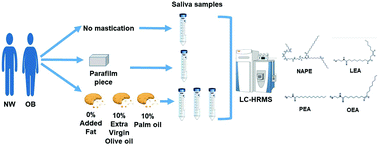N-Acylphosphatidylethanolamines and N-acylethanolamines increase in saliva upon food mastication: the influence of the individual nutritional status and fat type in food
Abstract
This study aimed to evaluate the influence of the individual nutritional status on the salivary concentration of N-acylethanolamines (NAEs), including linoleoylethanolamide (LEA), oleoylethanolamide (OEA), and palmitoylethanolamide (PEA), and their precursors N-acylphosphatidylethanolamines (NAPEs) upon mastication of biscuits containing different fats. Three types of biscuits were formulated with 10% extra-virgin olive oil (EVOB), 10% palm oil (PALMB) or 10% paraffin oil (0% lipids, CONB). Twenty-five healthy subjects, 12 normal weight (NW, 9 F, 30.4 ± 8.7 years) and 13 obese (OB, 8 F, 35.5 ± 10.7 years) participated in a randomized crossover study. Fasting subjects collected unstimulated saliva (US) and stimulated saliva by masticating a parafilm piece (PP), and CONB, EVOB and PALMB. NAPEs, LEA, OEA and PEA were quantified in saliva samples by liquid chromatography–high-resolution mass spectrometry. The results showed that salivary NAPE and NAE concentrations in OB were higher than in NW in both US (NAPEs: 280.0 ± 45.4 ng mL−1vs. 121.8 ± 24.4 ng mL−1, p = 0.015; NAEs: 10.8 ± 1.4 ng mL−1vs. 4.8 ± 0.8 ng mL−1, p = 0.002, respectively) and PP (NAPEs: 259.8 ± 47.1 ng mL−1vs. 121.7 ± 16.9 ng mL−1, p = 0.049; NAEs: 6.1 ± 0.8 ng mL−1vs. 3.8 ± 0.4 ng mL−1, p = 0.03, respectively). NAPE and LEA levels were similar in US and PP, while the levels of OEA and PEA were lower in PP vs. US. Compared to PP, biscuit mastication increased the salivary NAPEs, LEA, OEA and overall NAEs in NW and OB. NAPEs increased in the order of EVOB = CONB > PALMB in NW and EVOB > CONB = PALMB in OB. LEA, OEA and overall NAEs increased similarly with all the biscuits in NW and in the order of EVOB > PALMB > CONB in OB. In contrast, the PEA concentration did not vary in saliva upon biscuit mastication in NW and neither with EVOB in OB, while it lowered with CONB and PALMB in OB. In conclusion, OB showed higher salivary levels of NAPEs and NAEs than NW. Mastication itself did not vary salivary NAPEs and LEA but reduced OEA, PEA and overall NAEs. Biscuit mastication increased salivary NAPEs and all NAEs, but PEA. Altogether, the data suggested that NAPEs and NAEs were released in saliva from biscuits at levels influenced by the individual nutritional status and biscuit type. These findings may have implications in molecular mechanisms underpinning gustatory processes in humans.



 Please wait while we load your content...
Please wait while we load your content...